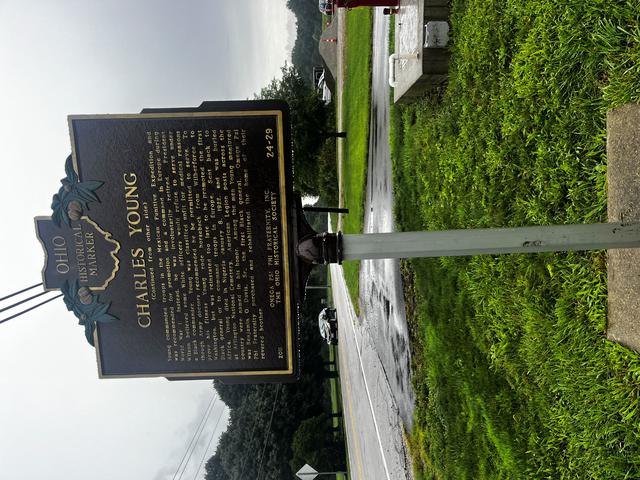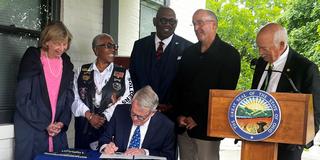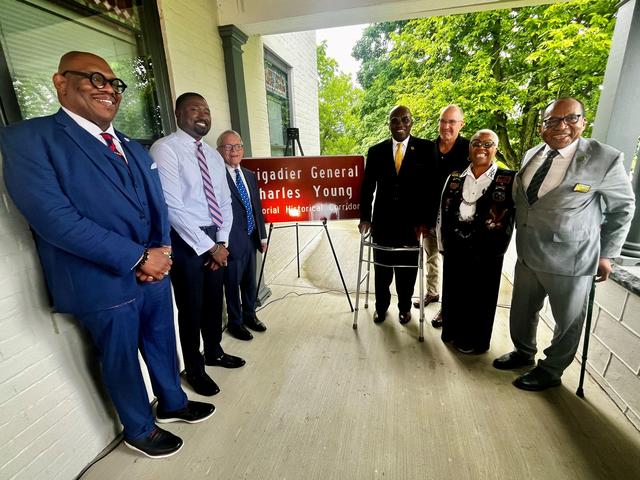
Ohio governor signs bill to create Brigadier General Charles Young Memorial Historical Corridor

Above: Ohio Gov. Mike DeWine (seated) signs House Bill 253, establishing the Brigadier General Charles Young Memorial Historical Corridor on July 22 at the Charles Young Buffalo Soldiers National Monument in Wilberforce.
In a ceremony marked by reflection and celebration of a resilient trailblazer, Ohio Gov. Mike DeWine signed House Bill 253 on Monday, July 22, 2024, establishing the Brigadier General Charles Young Memorial Historical Corridor. The 85-mile stretch of roadway pays homage to a man whose extraordinary life and military career left an indelible mark on American history.
The corridor begins at the Charles Young Buffalo Soldiers National Monument, 1120 U.S. 42, Wilberforce, and traverses through Greene, Clinton, and Brown counties, ending at the Simon Kenton Memorial Bridge near Ripley. This route, now officially recognized, symbolizes Brigadier General Young's journey and contributions, extending into Kentucky to culminate at the Camp Nelson National Monument, making the entire corridor a 170-mile tribute.
A legacy of service and courage
Born to enslaved parents in 1864 in Kentucky, Young overcame significant adversity to become the third African American to graduate from the U.S. Military Academy at West Point. His remarkable career included service as a military attaché, educator, and the first African American superintendent of a national park. He was known for his leadership and bravery, notably commanding troops during the Philippine-American War.

DeWine highlighted Young's perseverance and achievements, stating, “In the year (Young) was born, his father escaped slavery, joined the Fifth Regiment in what was then called the U.S. Colored Heavy Artillery. The family relocated across the river to Ripley, Ohio, seeking a new life. Charles found remarkable success in his academic pursuits, especially in foreign languages and in music. His mother was educated while she was a slave, which of course was rare at the time.”
“At age 17, (Young) graduated with honors at the top of his class from an integrated high school,” DeWine continued. “In 1883, he applied to the U.S. Military Academic at West Point. Though he scored second highest on the entrance exam, he was not chosen for the academy that year. He was, however, selected the following year. As a cadet, he persevered through indignities including racial insults, social isolation from instructors and other cadets. He was awarded his diploma and his commission in 1889 as second lieutenant, and he was assigned to the Ninth Cavalry in Fort Robinson, Nebraska, in the summer of 1889.”
In the fall of 1884, Young arrived in Wilberforce to plan and reach the new Military Sciences and Tactics courses at then-Wilberforce College, the precursor to Central State University, Ohio’s only public Historically Black College or University (HBCU), and Wilberforce University, the state’s only private HBCU. He built the program to over 100 cadets, the governor said, also establishing the Wilberforce Marching Band.
“He became a distinguished professor at the college around the turn of the century,” DeWine shared.
Young was medically retired in 1917, but he and his supporters asked for reconsideration. “To demonstrate that he was fit to serve, Young, at the age of 54, made his historic 500-mile horseback ride from right here in Wilberforce to Washington, D.C.,” DeWine added. “However, even after meeting with the undersecretary, he was not reinstated. He was, however, included on a list of active-duty officers and during World War II, he was sent back to Ohio to train African American recruits for the war.”
Young passed away in Lagos in 1922, after he became critically ill in Nigeria the year before.
“At the time of his death, he was the highest ranking African American officer in the Army,” the governor said.
“He was buried in Lagos for one year before his body was repatriated to the United States. Upon his body’s return to the United States, he received a hero’s welcome, and on June 1, 1923, Col. Charles Young became the fourth soldier honored with a funeral at Arlington Memorial Amphitheatre before being buried in Arlington National Cemetery.”
A unified effort
The creation of the memorial corridor was made possible through the efforts of several key figures and organizations. Ohio Reps. Terrence Upchurch and Adam Holmes, who co-sponsored HB 253, attended the bill signing, underscoring the bipartisan support for this important initiative.
State Sen. Paula Hicks-Hudson, a representative of the Toledo Buffalo Soldiers Motorcycle Club, also played a crucial role in advocating for the corridor's designation. She remarked on the significance of honoring Young, stating, “I want to thank the governor, Rep. Holmes, and Rep. Upchurch for honoring one of our what we consider the premier, the original, the best of all Buffalo Soldiers.”
Using the state slogan, Hicks-Hudson said:
“We are the heart of it all. And being a heart of it all, we have an example of a man whose heart was in not only service to his country, but also to be the epitome of what it means to be an African American at that time and in this place. … We stand together in the House and in the Senate to move this great state forward.”
A living monument
The corridor not only honors Young but also serves as an educational resource, providing visitors with opportunities to learn about his life and the broader history of African American contributions to the military. The Charles Young Buffalo Soldiers National Monument, maintained by the National Park Service, has undergone extensive renovations to reflect its historical period, thanks to the efforts of dedicated preservationists and community members.

Dr. Morakinyo A.O. Kuti, President of Central State University, and Dr. Vann R. Newkirk, President of Wilberforce University, were present at the signing ceremony, underscoring the importance of this recognition for the local community and beyond. "Brigadier General Young's story is an integral part of our shared history," said Dr. Kuti. "It is a story of breaking barriers and leading with integrity, which continues to inspire generations."
A celebration of history
The corridor's dedication is timed to coincide with National Buffalo Soldiers Day on July 28, a date that celebrates the contributions of African American soldiers throughout U.S. history.
The Brigadier General Charles Young Memorial Historical Corridor stands as a powerful symbol of resilience, leadership, and the enduring legacy of those who have fought for equity and justice. As visitors traverse this historic route, they are invited to reflect on the life of a man who, against all odds, rose to become one of the most distinguished military leaders of his time.
Learn more about Young at nps.gov/chyo.


